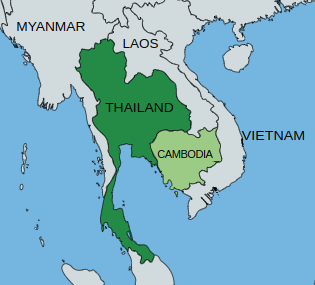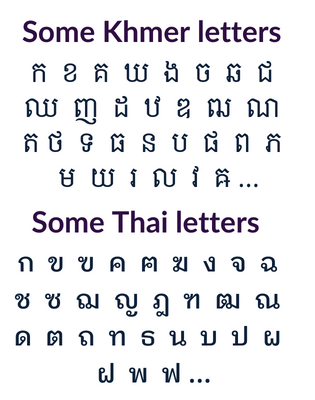Khmer and Thai: Language Similarities and Differences

The geographical proximity of Cambodia and Thailand, two neighboring countries in Southeast Asia, raises the question of whether their respective languages, Khmer and Thai, are similar.
In their written form, Khmer and Thai have a similar visual appearance because the Thai script was adapted from the old Khmer script. However, the two languages belong to different language families. In addition, Thai is a tonal language whereas Khmer is not.
| Language | Linguistic Family | Related Languages |
|---|---|---|
| Khmer | Austroasiatic languages | Vietnamese, Mon |
| Thai | Kra-Dai languages | Lao, and a few others |
Some historical background
Southeast Asian countries haven’t always looked the same on the map as they do today, and both Thailand and Cambodia have been influential in setting present-day borders. They share a border and have a long history of intermigration, trade, and—hundreds of years ago—war.
A significant period in Southeast Asian history is that of the Khmer empire which lasted from the 9th to 15th centuries, covering at its peak much of what is now Cambodia, Thailand, and Laos. Architectural legacies of that empire include the temple complex of Angkor Wat, which appears on the country’s flag, and is the largest religious building in the world.
Temples in Thailand dating from the Khmer empire era bear witness to its far-reaching influence. The most famous of these is in the town of Phimai in the country’s northeast. After the empire fell, skirmishes and war continued between Cambodia and Thailand, and the town of Siem Reap near Angkor translates literally as “victory over Siam,” as Thailand was then known.
Different writing systems with a common origin

There is a reason why written Khmer and written Thai look alike: the Khmer script and the Thai script have a common origin. Both descend from the Brahmi script which was used in ancient India.
As a result, the Khmer script and the Thai script share a common origin with the Devanagari script used for Hindi. One similarity between Khmer and Thai is that they do not use spaces to separate words (in contrast to Hindi).
Vocabulary comparison
Because Thai and Khmer belong to different language families, one might think that they have no vocabulary words in common. This is not the case.
Both of these languages have borrowed many Sanskrit words, particularly in the fields of religion and philosophy.
The following table contains some examples of words which are similar in Khmer and in Thai:
| Khmer | Thai | English |
|---|---|---|
| ភាសា (pheasaea) | ภาษา (paasaa) | language |
| ជីវិត (chivit) | ชีวิต (chīwit) | life |
| ទូរស័ព្ទ (toursap) | โทรศัพท์ (toorasap) | telephone |
| សត្វ (sat) | สัตว์ (sat) | animal |
| គ្រូ (kruu) | ครู (kruu) | teacher |
| អាហារ (ʼaahaa) | อาหาร (aahaan) | food |
| នាឡិកា (nealeka) | นาฬิกา (naaligaa) | clock |
| ប្រទេស (prɑteih) | ประเทศ (bprateet) | country |
| វិទ្យុ (vityu) | วิทยุ (wittayu) | radio |
| គិត (kit) | คิด (kít) | to think |
| អាន (an) | อ่าน (aan) | to read |
| ដើរ (daə) | เดิน (dəən) | to walk |
| ជួយ (cuəy) | ช่วย (chûai) | to help |
| លេង (leing) | เล่น (lên) | to play |
| Khmer Word | Thai Word | Meaning | Origin |
|---|---|---|---|
| សិក្សា (seksaa) | ศึกษา (suksaa) | to study | Sanskrit: शिक्षा (śikṣā) |
| បញ្ញា (panhnhea) | ปัญญา (bpanyaa) | intelligence or wisdom | Pali: paññā; Sanskrit: प्रज्ञा (prajñā) |
| ឧស្សាហ៍ (uhsaa) | อุตส่าห์ (utsaa) | to work hard | Sanskrit: उत्साह (utsāha) |
| វេលា (velea) | เวลา (weelaa) | time | Sanskrit: वेला (velā) |
Languages with many different pronouns
Khmer and Thai are languages which have many different pronouns, and the appropriate choice of pronoun depends on the relationship between the speaker and the listener.
This is similar to how French has both an informal and a formal “you” pronoun: “tu” and “vous”. In Khmer and in Thai, there are not just two, but at least four or five different “you” pronouns. There are also several different variants of the “I” pronoun in both of these languages.
Specific pronouns in Thai as well as in Khmer are used when addressing Buddhist monks, as well as some which are used when addressing royalty.
Some additional similarities
- As in most East Asian languages, Thai verbs and Khmer verbs do not inflect.
- Khmer and Thai have similar word order: both are SVO (subject-verb-object) languages.
- Kher and Thai are languages which use classifiers.
The Khmer language and the Thai language are spoken in neighboring countries (Cambodia and Thailand) and their writing system has a common origin. These languages have some cognate words (words with the same origin) as both have absorbed some Sanskrit vocabulary words. (see this comparison of Thai and Sanskrit)
However the similarities between Khmer and Thai are limited as they belong to different language families. Thai is closer to Lao than to Khmer (see this comparison of Thai and Lao).
To learn more about the Thai language, see these articles on Thai compliments and Thai words with multiple meanings.
Links